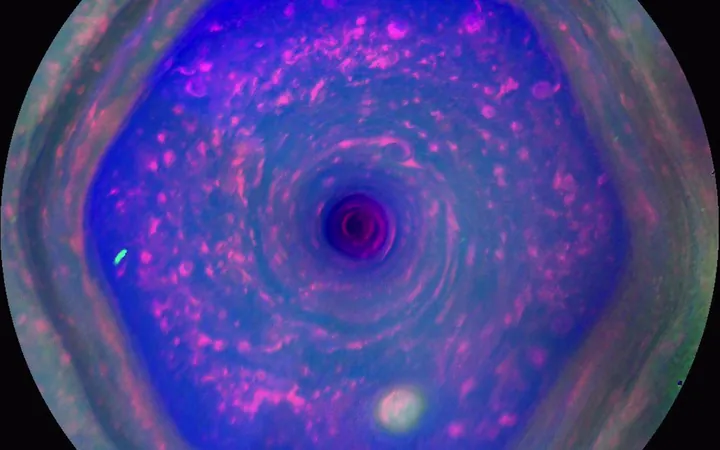
Mysterious 'Dark Beads' Discovered in Saturn's Atmosphere by James Webb Telescope!
2025-09-22
Author: Kai
A Cosmic Riddle Uncovered!
The James Webb Space Telescope (JWST) has astonished astronomers with a groundbreaking discovery: peculiar "dark beads" floating above a four-armed star pattern in Saturn's atmosphere. These enigmatic formations defy explanation and represent an unprecedented find in space exploration.
An Eye on Saturn!
Utilizing its Near Infrared Spectrograph (NIRSpec), JWST directed its gaze toward Saturn's swirling atmosphere, particularly above the planet's north pole, where a hexagonal storm reigns. Researchers anticipated a routine observation of emissions throughout the infrared spectrum, but instead encountered these dark, bead-like structures, appearing both scattered and possibly interconnected within Saturn's ionosphere.
Unexpected Discoveries!
"The results came as a complete surprise," exclaimed Tom Stallard, an astronomy professor at Northumbria University. "These features were completely unexpected and, at present, are completely unexplained." The findings were detailed in a recent publication in the journal Geophysical Research Letters.
The Mystery of Saturn's Hexagon!
First spotted by NASA's Voyager spacecraft in 1980, Saturn's Hexagon is a colossal 18,000-mile-wide (29,000 kilometers) structure that rotates every 10 hours. This six-sided phenomenon is thought to be driven by a jet stream at the planet's pole, although the exact mechanisms behind its shape and behavior remain a mystery.
Exploring Saturn's Atmosphere!
To delve deeper into this cosmic puzzle, astronomers focused the JWST’s NIRSpec on layers of Saturn's ionosphere and stratosphere, located approximately 684 miles (1,100 km) and 373 miles (600 km) above its surface. Over a marathon 10-hour observation period, the telescope tracked hydrogen molecules and methane across Saturn’s atmosphere, unveiling these peculiar structures.
Connections and Theories!
Stallard speculates that the dark beads could originate from complex interactions between Saturn's magnetosphere and its atmospheric dynamics, providing fresh insights into the planet's auroras. Intriguingly, the asymmetrical star pattern beneath the beads may have an unresolved connection to the hexagonal storm.
A Cosmic Coincidence?
"Tantalizingly, the darkest beads in the ionosphere align with the strongest star-arm in the stratosphere," Stallard noted. However, whether this alignment is mere coincidence or a sign of something deeper remains to be seen. This remarkable discovery opens a window into understanding Saturn's unique atmospheric phenomena.
Look Ahead!
As anticipation builds, sky-gazers should mark their calendars: Saturn will be particularly stunning and visible on September 21. Stay tuned as we continue to unveil the mysteries that our universe holds!




 Brasil (PT)
Brasil (PT)
 Canada (EN)
Canada (EN)
 Chile (ES)
Chile (ES)
 Česko (CS)
Česko (CS)
 대한민국 (KO)
대한민국 (KO)
 España (ES)
España (ES)
 France (FR)
France (FR)
 Hong Kong (EN)
Hong Kong (EN)
 Italia (IT)
Italia (IT)
 日本 (JA)
日本 (JA)
 Magyarország (HU)
Magyarország (HU)
 Norge (NO)
Norge (NO)
 Polska (PL)
Polska (PL)
 Schweiz (DE)
Schweiz (DE)
 Singapore (EN)
Singapore (EN)
 Sverige (SV)
Sverige (SV)
 Suomi (FI)
Suomi (FI)
 Türkiye (TR)
Türkiye (TR)
 الإمارات العربية المتحدة (AR)
الإمارات العربية المتحدة (AR)